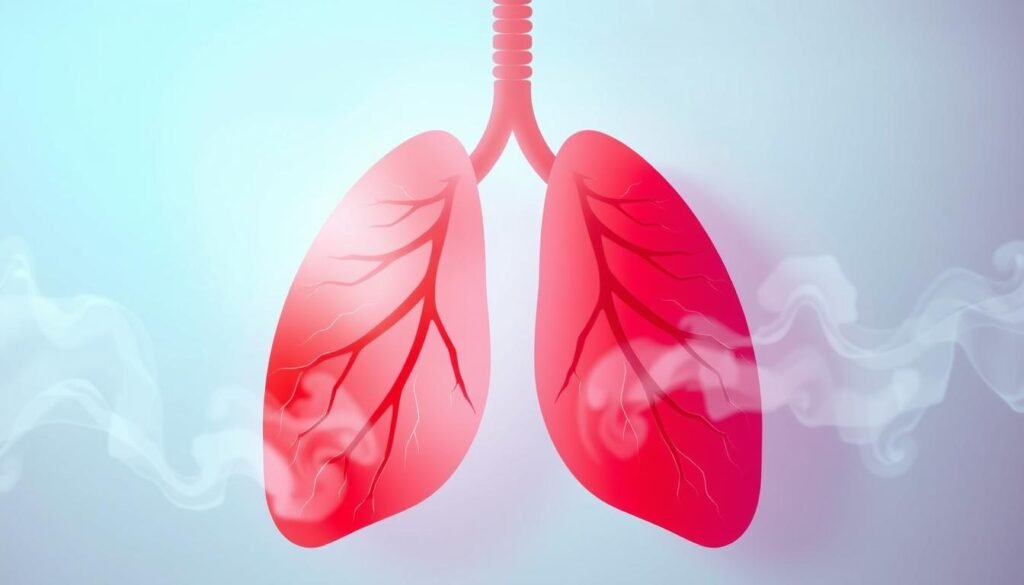The five-year survival rate for stage 4 lung cancer is only 11.1%. This low number shows the big challenges patients face with this severe disease. But, new treatments like immunotherapy are making a difference. They’re giving people new hope, improving how long and how well they live.
We’ll look into how immunotherapy is changing the outlook for stage 4 lung cancer patients. The average survival is now 474 days after finding out they have the disease. And, recent studies offer even more hope. It’s important to see how this treatment is making a big impact on survival rates.
Key Takeaways
- The estimated five-year survival rate for stage 4 lung cancer is around 11.1%.
- Recent advancements in immunotherapy are reshaping survival outcomes.
- The median overall survival for patients undergoing immunotherapy stands at 18.4 months.
- Approximately 25-30% of patients with stage 4 lung cancer have a life expectancy of under 3 months.
- The effectiveness of treatment can vary significantly based on patient-specific factors, including genetic changes in cancer cells.
Understanding Stage 4 Lung Cancer
Stage 4 lung cancer is a critical point in cancer’s journey. It’s where tumors spread to far-off organs. This advanced stage is also known as part of the TNM system. This system shows how much the disease has spread. There are two sub-stages in stage 4:
- Stage 4a – The cancer has spread nearby.
- Stage 4b – The cancer has spread far, even to the brain or liver.
People with stage 4 lung cancer face tough symptoms. They feel very tired, have trouble breathing, and suffer from pain. How long people live with this stage can be different for everyone. It depends on how they react to the disease and treatment.
The American Cancer Society says the five-year survival rate for stage 4 is only 9%. Survival times change based on the type of stage 4 lung cancer:
| Stage Classification | Median Survival Time |
|---|---|
| M1a | 11.4 months |
| M1b | 11.4 months |
| M1c | 6.3 months |
The outlook depends on many factors, like age, overall health, and other health problems. Stage 4 lung cancer often comes with other health issues. These can influence how long one lives and what treatments can help.
The Importance of Life Expectancy Metrics
Life expectancy metrics are crucial for people with stage 4 lung cancer. They help to understand what to expect and how to choose treatments. For example, the five-year survival rate gives essential insights into the outlook for such advanced lung cancer. Despite the tough odds, medical progress is helping more patients live longer than expected.
Preferences between living a longer life or a better-quality life differ among patients. Older people usually prefer a good quality of life. Younger ones might opt for treatments that could extend their lifespan. Studies show that health and personal choices greatly affect these decisions. Healthier patients often seek to increase their lifespan, while those in worse health might choose quality over quantity.
In the past 30 years, we’ve seen new ways to measure cancer treatment success. These methods consider how treatments affect life quality along with survival rates. This has improved how we understand lung cancer survival. It’s also made care better by valuing both the length and quality of life equally.

Stage 4 Lung Cancer Immunotherapy Life Expectancy
For patients with stage 4 lung cancer, new treatment options are coming up. Immunotherapy is becoming a key treatment, especially for those with non-small cell lung cancer (NSCLC). It targets the PD-1 and PD-L1 pathways, offering hope for longer life expectancy.
About 7% of people with stage 4 NSCLC survive for five years, thanks to current treatments. Even though the average survival is 4 to 9 months after diagnosis, some live for over ten years. Age, health, and treatment details can change outcomes.
A 2021 study showed that getting a mix of treatments could add up to 10 to 15 years to a patient’s life. Using chemotherapy along with immunotherapy can stop the cancer from worsening. This mix can help patients look forward with more hope, despite having stage 4 lung cancer.

| Type of Lung Cancer | Average Life Expectancy (Months) | Five-Year Survival Rate (%) |
|---|---|---|
| Non-Small Cell Lung Cancer (NSCLC) | 4-9 | 7 |
| Small Cell Lung Cancer (SCLC) | 8-13 | 3 |
| With Advanced Treatment | 10-15+ | Varies |
The expectancy of life for stage 4 lung cancer patients varies with each case, due to treatments getting better. Research keeps bringing new chances for extending lives, offering hope against a tough diagnosis.
Current Treatments for Stage 4 Lung Cancer
Stage 4 lung cancer is tough, but there are treatments available. It’s crucial for patients and families to know about these methods. Treatments like chemotherapy and immunotherapy aim to lessen symptoms and boost survival rates.
Overview of Immunotherapy Treatments
Immunotherapy is changing the way we fight lung cancer. It uses the body’s immune system to go after cancer cells. Checkpoint inhibitors, like pembrolizumab and nivolumab, are key players. They remove blocks on immune responses. This helps the immune system attack tumors.
Studies suggest that using immunotherapy with chemotherapy might lead to better results. It’s good compared to chemotherapy alone.
Checkpoint Inhibitors: Mechanism of Action
Checkpoint inhibitors are a type of immunotherapy. They boost the immune system’s fight against cancer. They stop the signals that let cancer hide. By targeting pathways such as PD-1 or CTLA-4, they strengthen the fight against cancer cells. This can lead to longer survival for some patients.
Understanding how these inhibitors work is key. It shows why they can provide major benefits. It’s crucial for patients to talk about these treatments with their doctors to find the best plan.
| Treatment Type | Examples | Indications |
|---|---|---|
| Immunotherapy | Pembrolizumab, Nivolumab | Non-small cell lung cancer, small cell lung cancer |
| Chemotherapy | Carboplatin, Paclitaxel | Advanced-stage lung cancer |
| Targeted Therapy | Osimertinib | Specific mutations in lung cancer |
| Palliative Treatments | Radiotherapy, Stent Placement | Symptom control |
For detailed info on living with stage 4 lung cancer, see the latest expert insights. Knowing about treatment choices is crucial for informed cancer care decisions.
Advanced Lung Cancer Prognosis Facts
For patients and doctors, understanding advanced lung cancer’s outlook is crucial. The future can look different for many, as several factors change it. Knowing the stats helps see what outcomes might be for those with this diagnosis.
Five-Year Survival Rates
The five-year survival for stage 4 lung cancer is around 9%. This means about 9 in 100 people might live five years after finding out they have it. It’s worth noting that survival rates for individual lung cancer survival rates can vary. For instance, patients under 50 have a survival rate of about 14.2%. But, for those 65 and older, it drops to 5.6%. These differences underline the complexities of advanced lung cancer prognosis.
Factors Influencing Survival Rates
Many things can affect survival rates in stage 4 lung cancer. These factors include:
- Age at diagnosis
- Sex of the patient
- Overall health and fitness level
- Specific tumor characteristics and genetic mutations
Understanding these factors can deeply impact the discussion on survival times and treatments. This knowledge is powerful for those facing advanced lung cancer.

The Role of Clinical Trials in Life Expectancy
Clinical trials are key in making progress in lung cancer treatments. They are especially important for patients with advanced lung cancer. Through these studies, patients can try new treatments not yet available to everyone. This research provides valuable data on how effective treatments are and can greatly improve patient outcomes.
Participation Benefits and Opportunities
Being part of a clinical trial has many benefits for patients with advanced lung cancer. Here are some advantages:
- Access to cutting-edge treatments that may improve life expectancy.
- Involvement in research that contributes to the understanding of lung cancer and its progression.
- Close monitoring by medical professionals, leading to personalized care and attention.
- Potential to benefit from emerging therapies that target specific cancer pathways.
- Opportunities to contribute to advancements in cancer treatment for future patients.
Recent clinical trials show promising results for improving lung cancer survival rates. For example, treatments combining immunotherapies like ipilimumab and nivolumab have improved survival for advanced non-small cell lung cancer (NSCLC) patients. Joining these studies offers hope and helps shape the treatments of tomorrow.
| Trial Name | Treatment | Overall Survival Rate | Patient Population |
|---|---|---|---|
| KEYNOTE-001 | Pembrolizumab | 31.9% | NSCLC Patients |
| KEYNOTE-024 | Pembrolizumab | 26.3 months | Advanced NSCLC Patients |
| CUSTOM | Combination Therapy | 54% long-term survivors | Participants meeting SEER criteria |
Taking part in clinical trials can lead to a longer life and better survival rates for lung cancer patients. This shows how vital these studies are in the fight against lung cancer.
The Impact of Targeted Therapies
Targeted therapies have changed the way we treat advanced lung cancer. These treatments focus on certain genetic mutations or biomarkers in tumors. They are different from the usual chemotherapy techniques. As these therapies advance, combining them with immunotherapy shows promise for better patient results.
How Targeted Therapies Differ from Traditional Treatments
Targeted therapies aren’t like traditional chemotherapy, which goes after all quickly dividing cells. These treatments are more specific, targeting the molecular changes that cause cancer to grow. This approach means better results and fewer side effects.
- Targeted therapies improve treatment success for patients with certain mutations.
- They often result in longer times without disease progression. Patients tend to handle these treatments better than the usual ones.
The mix of targeted therapies and immunotherapy can greatly enhance survival rates. Studies show patients treated with both do better in the long run than those with chemotherapy alone. For example, data shows a big increase in median survival time. This proves the benefit of using these therapies together.
| Treatment Type | Median PFS | Median OS |
|---|---|---|
| Targeted Therapy + Immunotherapy | 13 months | 45 months |
| Chemotherapy Alone | 7 months | 17 months |
These findings reveal the potential of targeted therapies to improve treatment outcomes. While results may vary, combining targeted therapies and immunotherapy is key in lung cancer care today. This personalized approach allows doctors to choose the best therapies for each patient, improving chances for a better life and survival.
Studies show the great value of targeted therapies in advanced non-small cell lung cancer. They play a crucial role in modern cancer treatment strategies.
Palliative Care as a Complementary Approach
Palliative care is crucial for those with advanced lung cancer. It aims to ease symptoms and improve life quality for patients and families. Many lung cancer patients deal with severe dyspnea, affecting 55% to 87% at all disease stages. By focusing on comfort, palliative care greatly enhances treatment experiences.
Patients also struggle with issues like chronic obstructive pulmonary disease (COPD), related to lung cancer aside from smoking. Pulmonary rehabilitation boosts oxygen transport and lessens breathlessness. This lets patients live more actively. The skills learned help build confidence and self-efficacy.
- Palliative care interventions target symptom management, psychological support, and family well-being.
- Studies show that 33% of cancer survivors report pain, underlining the need for palliative care.
- Such care also leads to fewer cases of severe pain in advanced diseases.
Palliative care also supports emotional well-being, especially for family caregivers facing stress and grief. The American Society of Clinical Oncology highlights the need for early quality-of-life care talks.
Starting palliative care early helps patients make informed choices during their care, leading to better outcomes. It combines medical treatment with supportive care, improving life quality and sometimes survival rates. For insights on adding surgical solutions for conditions like non-small cell lung cancer, check out this resource.
Conclusion
Stage 4 lung cancer brings big challenges. But, treatments are getting better and changing how we view survival. Now, immunotherapy for this cancer shows hope. It’s giving people about 16.4 months to live, more than with old treatments. This is key in deciding how to fight the cancer.
Many people find out they have non-small cell lung cancer at stage IV. About 60% to 70%, in fact. New treatments are making a difference for them. Especially for those with certain genes. These advances mean they could live longer.
Research and trials are super important for lung cancer. They help us find new ways to help patients live better and longer. By joining these studies, patients aid in making new treatments. This brings hope and a brighter future for those dealing with this tough journey.